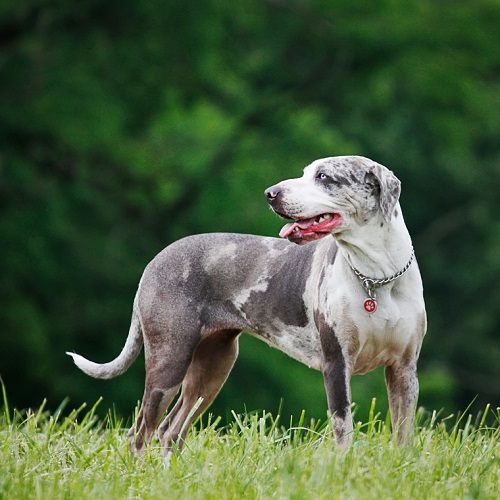When do Catahoulas Calm Down? Get expert guidance on their typical energy traits and learn how to care for them!
Catahoula is a unique breed known for its captivating eyes and versatile skills and has gained popularity in recent years. However, one question often arises among their owners and enthusiasts—When Do Catahoulas Calm Down?
Understanding Catahoulas and their Energy Levels
Catahoulas, also known as Louisiana Catahoula Leopard Dogs, are incredibly energetic and active dogs known for their agility, stamina, and endurance. They are working dogs at heart and, as such, require a significant amount of exercise and mental stimulation to keep them healthy and content. However, if left without sufficient outlets for their energy, Catahoulas can become restless and may develop destructive behaviors.
The dog’s high energy levels peak during their adolescent stage, typically around 6 to 18 months of age. During this time, their curiosity and boundless energy can make them quite a handful, requiring plenty of physical exercises and mental stimulation. As puppies, they’re energetic and playful, though they may tire quickly due to their small size and developing bodies.
As Catahoulas transition into adulthood, usually around two years of age, they tend to maintain their high energy levels, but they typically become more predictable in their energy patterns. Senior Catahoulas, aged seven and above, generally have lower energy levels compared to their youthful counterparts. However, they still require regular exercise to maintain their health and fitness.
Check out Can I Feed My Dog Raw Meat from Supermarket | Potential Health Benefits and Concerns here
When do Catahoulas Calm Down?

Catahoulas typically start to calm down around the age of two to three years. However, it’s important to note that every dog is an individual, and the timing may vary. Catahoulas are a working breed with strong herding instincts, so their energy levels naturally decrease as they mature.
Providing them with adequate exercise, mental stimulation, consistent training, and socialization from a young age can contribute to a well-rounded and calmer Catahoula. While they may never become couch potatoes, their intense bursts of energy will gradually decrease over time.
Why do Catahoulas take Time to Calm Down?
Originally bred for work such as herding and hunting, Catahoulas possess an innate drive to be active and engaged, which explains why they often take time to calm down. This energy is part of their genetic makeup, and it’s what makes them excellent working dogs.
This breed also has a high degree of intelligence and curious nature, which means they need mental stimulation as well as physical exercise. Additionally, Catahoulas are known for their loyalty and protective instincts. They are always on alert and ready to protect their family, which can sometimes come across as them being excessively energetic. They may take longer to relax, especially in new or unknown situations where their protective instincts are heightened.
Check out Can Dogs Eat Deviled Eggs? here
How to Calm Catahoulas?

1. Show Disapproval
When your Catahoula displays hyperactive behavior, it’s important to establish boundaries and communicate disapproval. Use a firm, calm voice, and body language to let them know that their behavior is not acceptable. Avoid shouting or aggressive actions, as this can escalate the situation.
2. Address Hyperactive Behaviors
Identify specific hyperactive behaviors that your Catahoula engages in and work on addressing them. For example, if they tend to jump on people when excited, teach them the “sit” or “down” command and reward them for calm behavior.
3. Channel Energy Positively
Catahoulas are an energetic breed and need outlets to release their energy. Engage them in regular exercises such as long walks, jogging, or play sessions. Mental stimulation, such as puzzle toys or training exercises, can also help tire them out and redirect their energy.
4. Reinforce Good Behavior
Positive reinforcement is key to training a Catahoula. Whenever they exhibit calm behavior or follow your commands, reward them with treats, praise, or playtime. This helps them associate calm behavior with positive outcomes and encourages them to repeat it.
5. Employ Aromatherapy
Aromatherapy can be used as a complementary technique to promote relaxation and calmness in your Catahoula. Lavender, chamomile, and valerian essential oils are known for their calming properties. However, it’s important to consult with a veterinarian or a professional in aromatherapy for guidance on safe and appropriate usage.
Training Catahoulas for Calmness
Early training is crucial for Catahoulas due to their high intelligence and quick learning abilities. These dogs are receptive to training and can thrive when provided with proper guidance. Consistency, patience, and empathy are key factors in training a Catahoula effectively.
- Consistency: Establishing a consistent training routine is essential. Catahoulas respond well to predictable patterns and clear expectations. Consistency helps them understand what is expected of them and reduces confusion or anxiety.
- Patience: Training a Catahoula requires patience. These dogs may be independent and strong-willed at times, so it’s important to remain calm and composed. Rushing or becoming frustrated can hinder the training process. Take the time to understand your Catahoula’s individual needs and learning pace.
- Empathy: Showing empathy towards your Catahoula is important during the training process. Dogs, including Catahoulas, thrive on positive reinforcement and encouragement. Avoid using harsh punishment or negative reinforcement, as it can lead to fear or anxiety. Instead, focus on rewarding good behavior and providing positive feedback.
- Seeking Professional Training Guidance: First-time owners, in particular, can benefit from seeking professional dog training guidance. A professional trainer can provide insights, techniques, and strategies tailored to your Catahoula’s specific needs. They can help you navigate the training process more effectively and address any challenges that may arise.
Check out Can Dogs Eat Takis? Yes or No? here
Essential-Mental Stimulation and Enrichment
Mental stimulation is crucial for calming Catahoulas. Engaging their minds with various activities and challenges helps prevent boredom and hyperactivity. Here are some effective methods:
- Interactive Games: Play interactive games with your Catahoula, such as hide-and-seek, scent games, or fetch. These games stimulate their problem-solving abilities and keep their minds engaged.
- Puzzle Toys: Provide puzzle toys that require your Catahoula to figure out how to access treats or toys hidden inside. These toys stimulate their intelligence and keep them occupied for extended periods.
- Obedience Training: Engaging in regular obedience training sessions helps stimulate a Catahoula’s mind and improves their overall behavior. Training sessions provide mental challenges and strengthen the bond between you and your dog.
Can Alternative Approaches Help in Calming Catahoulas?

While natural supplements and remedies are available in the market, and some people find them helpful, it’s important to consult with a veterinarian before introducing any new substances to your Catahoula’s routine. Natural supplements, such as herbal remedies or calming pheromone products, are often marketed as aids for relaxation and reducing anxiety in dogs. However, their effectiveness can vary from dog to dog, and individual reactions may differ.
Here are a few natural approaches that some owners have found useful:
- Lavender: The scent of lavender is known for its calming properties in humans, and some dog owners use lavender-infused products or essential oils to create a soothing environment for their dogs. However, it’s important to use these products with caution and consult a veterinarian, as essential oils can be toxic if not used properly.
- Valerian Root: Valerian root is a natural herb that is sometimes used to promote relaxation and reduce anxiety in dogs. It can be found in various forms, such as herbal supplements or teas. Again, it’s crucial to consult with a veterinarian to ensure the proper dosage and potential interactions with any medications your Catahoula may be taking.
- Calming Pheromone Products: Synthetic versions of calming pheromones, which mimic the pheromones produced by mother dogs to comfort their puppies, are available as sprays, diffusers, or collars. These products are designed to create a sense of security and relaxation in dogs. Some owners have reported positive results with these pheromone-based products, but individual responses may vary.
Note: Keep in mind that natural supplements and alternative approaches should not be seen as a standalone solution. They are often most effective when used in conjunction with a holistic approach that includes proper exercise, training, and a calm and structured environment.
Check out Are Ramen Noodles Safe for Dogs here
Quick Takeaways
Catahoulas generally start to calm down around 6-12 months of age, but it requires effort and effective strategies to manage their hyperactivity. By understanding their energy levels, employing appropriate techniques, and providing consistent training and mental stimulation, you can help your Catahoula become a well-behaved and calm companion. Remember to be patient, persistent, and maintain a positive mindset throughout the training process.
FAQs
1. How do Catahoulas Show Affection?
Some common ways Catahoulas may display affection include leaning against their owners, cuddling or snuggling, wagging their tails, giving gentle kisses or licks, and seeking physical contact, such as sitting or lying close to their owners. They may also show affection through attentive and focused behavior, following their owners around, or seeking out their attention.
2. Are Catahoula Dogs Calm?
Catahoula dogs are known for their high energy levels and working abilities. They are typically active, alert, and intelligent dogs. While Catahoulas can have calm moments, especially when they have received enough exercise and mental stimulation, they are generally not considered calm dogs by nature.
They require regular physical exercise, mental stimulation, and engaging activities to help channel their energy in a positive way. Without adequate outlets for their energy, Catahoulas may become bored or restless, which can lead to behavioral issues.
3. Are Catahoulas Stubborn?
Catahoulas are often described as intelligent and independent-minded dogs. While they are intelligent and quick learners, they can also exhibit a level of stubbornness or strong-willed behavior. This trait is rooted in their working background as versatile and assertive herding dogs.
4. How do I keep my Catahoula Busy?
To keep your Catahoula busy and mentally stimulated, provide them with regular exercise and engaging activities. Catahoulas thrive on physical and mental challenges. Here are some ideas to keep them busy:
- Daily Exercise: Engage your Catahoula in long walks, runs, or vigorous play sessions to help burn off their energy.
Interactive toys: Provide puzzle toys or treat-dispensing toys that require problem-solving or encourage them to work for their rewards. - Obedience Training: Regular training sessions help keep Catahoulas mentally stimulated and provide an outlet for their intelligence.
- Agility or Obedience Classes: Enroll your Catahoula in agility or obedience classes to provide structured training and mental challenges.
- Nose Work or Scent Games: Engage your Catahoula’s natural scenting abilities by playing hide-and-seek games with treats or engaging in scent work activities.
- Mental Enrichment: Engage your Catahoula’s mind with tasks like obedience drills, learning new tricks, or teaching them to retrieve specific items.
